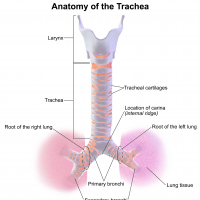Six-year-old Katie Parke suffers from pulmonary alveolar proteinosis – a rare condition which causes a buildup of sand-like particles in the alveoli (microscopic air sacs responsible for gas exchange with the blood) of the lungs. The only way to treat Katie’s condition is to periodically wash out her lungs with a saline solution. Needless to say, having one’s lungs washed is a rather intense and intricate affair. Specially-sized tools are needed for the ventilation of one lung lobe, while the other is filled with saline. Most of the time, in order to keep Katie breathing, doctors would have to try out different sizes of tubed devices in order to ventilate the non-saline-filled lung. Essentially Katie is being drowned, one lung at a time.
Now, the Northern Irish girl can spend less time on the operating table, and undergo safer surgical procedures because of 3D printing. Using a CT scan of Katie’s windpipe, doctors at London’s Great Ormond Street Hospital are now able to 3D print a rubber, biocompatible version of her trachea prior to the surgery. This saves the doctors time and, more importantly, it saves Katie time from being under anesthesia, and on the operating table.
Dr. Owen Arthurs, told BBC News, “We can look at a 3D reconstruction on a computer, but this takes it into a whole new dimension. Being able to hold it in your hand makes the procedure much easier and safer.” He also spoke of the future implications for this sort of procedure, adding, “It could also be used to make training better, being able to print a part of the anatomy is quite powerful. It’s really important to train the next generation of doctors and make them better.” Katie’s mother Sharon was equally amazed by the new treatment and said that Katie can now go horseback riding – an activity completely impossible before this new procedure.
3D printing in the realm of medicine is arguably the most important frontier. It has immediate implications to improve and save lives, and the potential to completely transform many of the riskiest surgical procedures. Unlike 3D printing of internal organs, which is still in its early stages, 3D printing of renewable and potentially disposable bio-parts – like the one used in Katie’s procedures, are being used in more and more procedures. CT scanning and 3D printing has allowed Katie to breathe a whole lot easier.




